What was it like to live at Los Alamos during the Manhattan Project? As thousands worked to build a top-secret atomic device, the US military tried to keep the entire city secret. All mail was screened and sent through a fake address at the University of California. The security team warned residents to never use their real names, and to cancel all their magazine subscriptions. And the FBI even investigated the head librarian, suspecting that she was sharing secrets with the communists.
Yet at the same time, residents attended square dances, went on horseback rides, and drank ethyl alcohol at raging parties. Los Alamos history during WWII contains contradictions. It was both a military facility and a scientific research project. Civilian residents had to obey the orders of a military commander and follow strict rules of secrecy. However, with its own radio station, soda fountain, and frequent social events, Los Alamos could, at times, feel like any close community in the USA – rather than a secret project to build the most destructive device in history.
These photographs from the detonation of the atomic bomb stunned the world. They also stunned the very people working on the Manhattan Project. As physicist J. Robert Oppenheimer told the men and women of Los Alamos after the first successful atomic test, “You are heroes today, but in a very short time you will be criticized for what you have done here.”
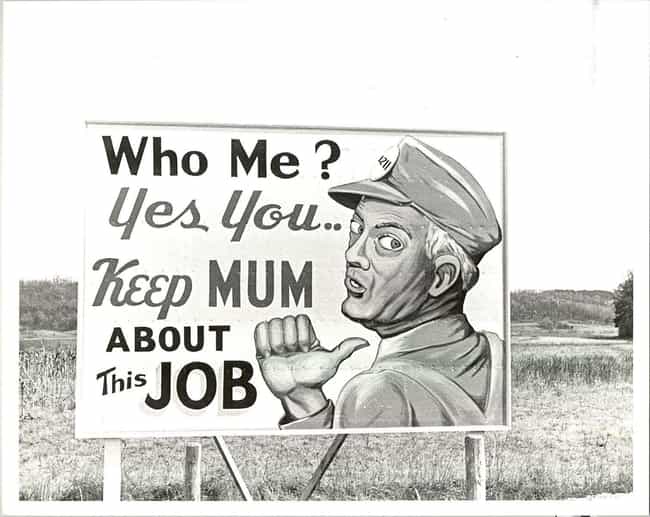
Billboards Warned, ‘Keep Mum About This Job’
Secrecy was the top priority at Los Alamos during WWII. But with 150,000 people participating in the Manhattan Project [at various locations around the country], keeping the work top-secret was a major challenge.
The government chose [the location at] Los Alamos because it was so remote, but secrecy required more than geographic isolation. Everyone living at Los Alamos needed security clearance and went through multiple security checkpoints to access the facilities. Armed guards protected the perimeter, along with barbed-wire fences.
Residents were constantly warned not to leak any information, with one billboard warning, “Keep mum about this job.”

Scientists Took Ethyl Alcohol From The Labs To Throw Raging Parties
Scientists worked long hours at Los Alamos, convinced that their efforts could turn the tide in WWII. [But] they also made time for parties.
“Everybody in my dorm would get together, chip in, and give a dorm party. Because it was dusty, muddy, rainy, snowing, you wore boots and things to work,” says Rebecca Diven, an engineer and the wife of a Manhattan Project scientist. “We’d have a crew set up and clean up and then we would have punch in which somehow alcohol would magically appear, and we could make punch and different things.”
That punch came from the scientific laboratories. Physicist Albert Bartlett recalls, “The basic ingredient of the punch in the dorm parties was ethyl alcohol from the laboratory stock… A lot of times, the punch was pretty strong.”
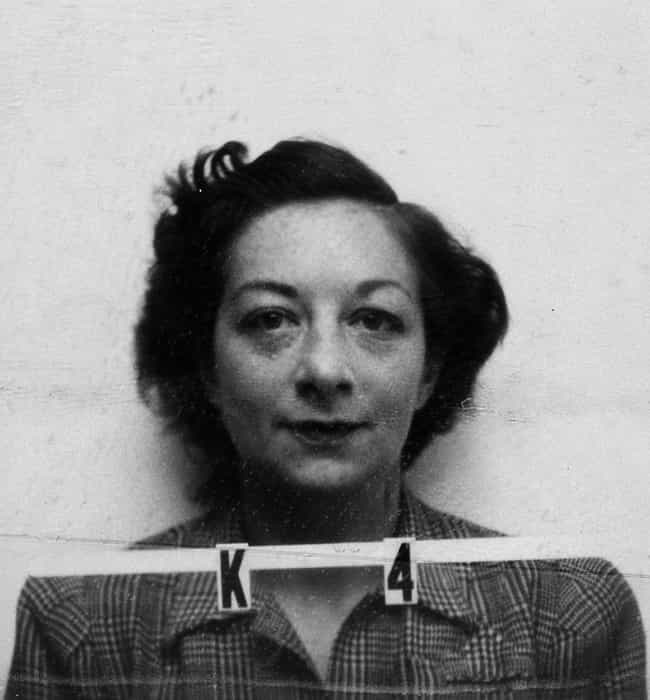
The Librarian In Charge Of Secrecy Was Investigated By The FBI
Charlotte Serber was a close friend of J. Robert Oppenheimer, the lead scientist on the Manhattan Project. Oppenheimer asked Serber to serve as the librarian at Los Alamos.
Serber struggled to maintain strict rules of secrecy in the library. She instituted nightly sweeps of the library to make sure that top-secret documents were never left out in the open. One night, Serber confronted a scientist who left out technical documents. According to Serber, “He argued that since the report was completely wrong, giving it to the enemy would be a service to the war effort.”
Still, the FBI suspected Serber of serving the enemy. She was investigated in 1943 on suspicion of communist sympathies. Although the US Army recommended firing Serber, Oppenheimer insisted she was trustworthy.
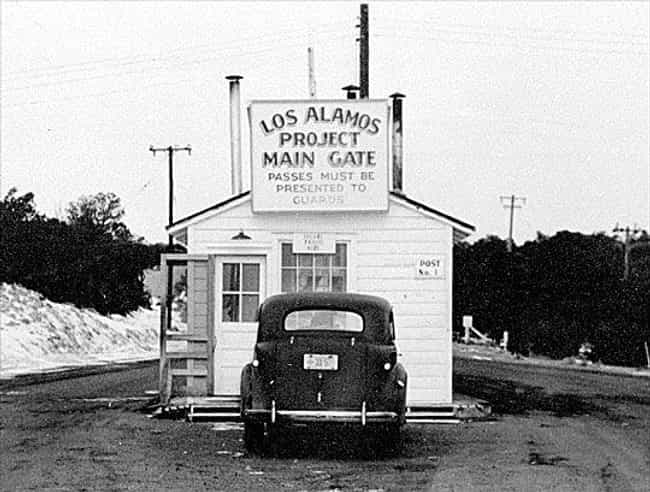
Babies Born At The Secret Facility Had PO Box 1663 On Their Birth Certificate
During the years of the Manhattan Project, Los Alamos experienced a baby boom. According to Dolores Heaton, who grew up at the facility, “Los Alamos had no crime. There was no kidnapping. It was an ideal situation to have children – to be able to have this kind of freedom, to grow up in this environment.”
But babies born at Los Alamos were also shrouded in secrecy. Instead of their birth certificates listing a location of birth, they simply read PO Box 1663, Santa Fe, New Mexico.
As John Mench, an engineer at Los Alamos, explains:
My daughter’s birth certificate says… that she was born in Post Office Box 1663 in New Mexico, because that’s the only way this place was designated. And everything that came to Los Alamos, whether it was a 10-ton machine or whether it was a postcard, came to Post Office Box 1663. And that’s where my daughter was born, still has [it on] her birth certificate.
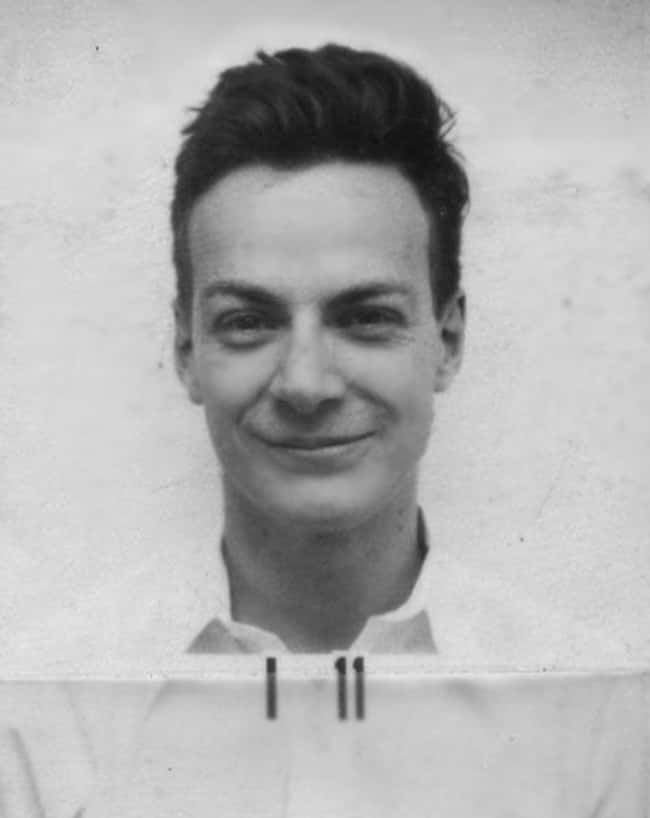
Physicist Richard Feynman Got In Trouble With Censors For Exchanging Coded Letters With His Wife
All mail to Los Alamos went through rigorous screening from the Office of Censorship. Strict rules stated that residents were never allowed to state their precise location, “except that it is in New Mexico.” Residents also could not describe how many people – “either military or civilian” – were participating in the project. Letters could never mention the names of anyone working at Los Alamos, and, of course, censors blocked any information about the work on the atomic device.
Scientists not used to the strict rules sometimes fought the censors. Physicist Richard Feynman, known as the town prankster, got in trouble with censors by flaunting the rules. His wife, Arline Greenbaum, lived in Albuquerque while Feynman worked on the Manhattan Project. Greenbaum mailed coded letters to Feynman, which he deciphered and returned.
Feynman also irritated censors by whiting out words and passages in his letters. He and his wife practiced their cryptography skills under the nose of the censors – who didn’t appreciate the joke.
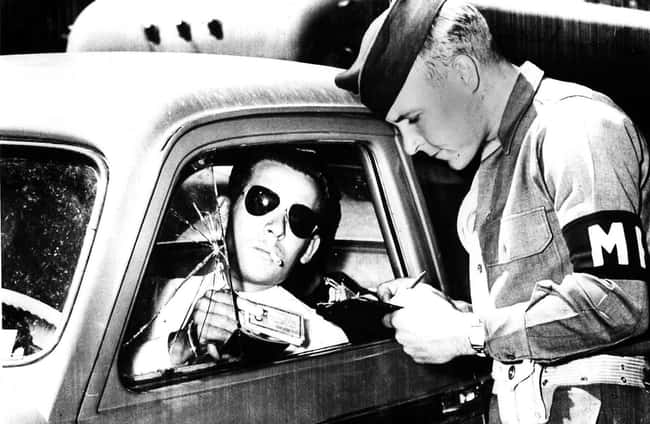
One Couple Went Undercover In A Santa Fe Bar To Trick Spies
During the Manhattan Project, scientists and civilians sometimes tried to help the effort by throwing people off their tracks. In Santa Fe, where the new military installation at Los Alamos was hard to miss, residents began wondering what, exactly, the scientists were building at the top-secret facility [up on “The Hill”].
Physicist Robert Serber and his wife Charlotte, the head librarian at Los Alamos, decided to spread some misinformation. They visited a bar in Santa Fe, spreading a lie that scientists were working on “an electric rocket” at Los Alamos.
However, the Serbers discovered it was much harder to spread false information than they suspected. While dancing with a local man, Charlotte pressed him: “What’s your guess about what cooks up there?”
He responded, “Beats me. Don’t care. May I have another dance later?”
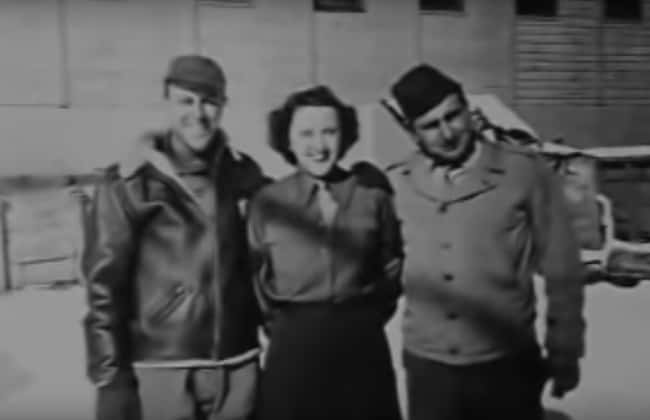
Residents Were Ordered To Cancel Their Magazine Subscriptions
When civilians moved to Los Alamos, they had to cut off contact with the outside world. The military police took over the mail, censoring all correspondence. The town’s mail was also routed through a secret address at the University of California to throw off potential spies.
Scientists at Los Alamos couldn’t receive magazine subscriptions. The military worried that if too many scientists’ names appeared on subscription lists, it might look suspicious.
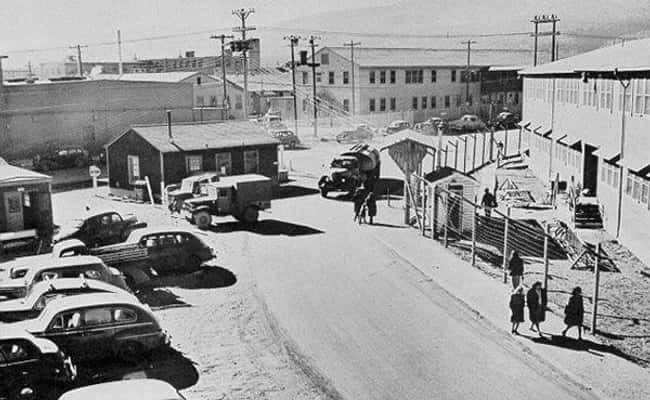
Scientists Rebelled Against The Strict Rules Of Military Life
Los Alamos was both a military facility and a scientific research project. However, scientists often chafed under the strict rules of military life.
General Leslie Groves, the commander at Los Alamos, tried to enforce compartmentalization to maintain secrecy. Oppenheimer, the head scientist, insisted on weekly scientific colloquia between the top scientists, but Groves demanded no communication between other divisions.
The scientists also rebelled against the military’s plan to use an atomic bomb. A group of scientists reached out to the Minister of War, urging him to avoid using the device on populated areas.
Physicist Victor Weisskopf lamented, “We never managed to shake off the searching question as to whether it was morally acceptable to use a weapon with such enormous destructive force.”
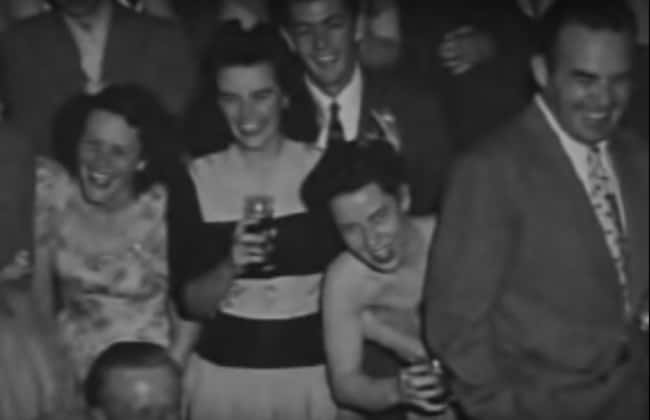
Los Alamos Had Its Own Radio Station, An Orchestra, And Square Dances
Though hidden from sight behind military fences, Los Alamos was a town like many others in the United States. Residents threw dance parties featuring the Keynotes, a Los Alamos band.
Resident Berlyn Brixner says that both the military and civilian populations enjoyed the social event:
Dancing was also a favorite. Square dancing. The military base commander was particularly interested in square dancing, so he naturally was all for it and was generally the head man there at the square dance.
Los Alamos also featured an orchestra and theatrical plays. Residents could listen to Los Alamos radio station, KRS [later renamed KRSN], which played music and skits.
“In retrospect, it is pretty funny: in a place that was so obsessed with secrecy, certainly you could hear the radio station outside the fence,” says Ellen Bradbury Reid, who grew up at the facility.
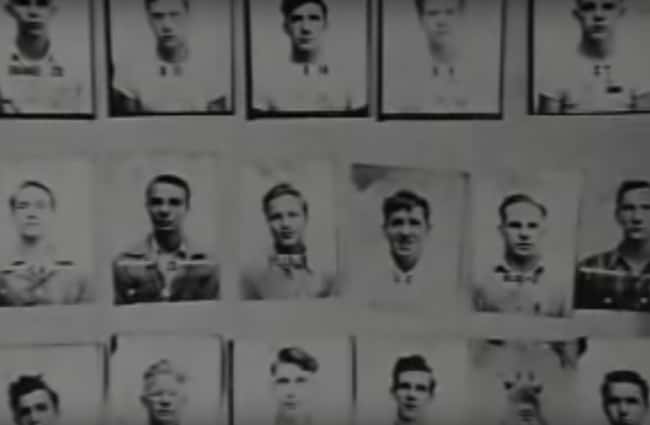
Everyone Lived Under A Secret Name In The Secret City
Los Alamos housed the world’s top scientists, and everyone at the facility lived under a secret name.
Secrecy was strictly enforced, and scientists weren’t allowed to even tell their spouses about their work. They had to request authorization to leave the facility, or order new equipment.
Los Alamos was known as a “secret city.” As the military leaders reminded residents, “What you see here, what you do here, what you hear here, when you leave here, let it stay here!”
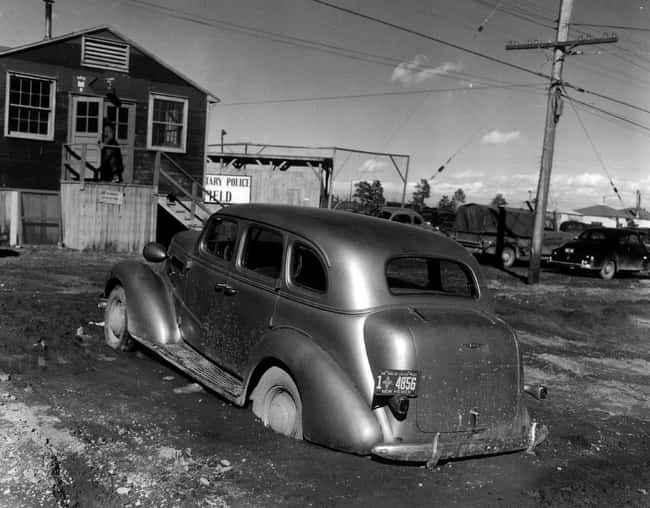
Scientists Nearly Spilled The Secret By Visiting The Public Library
Sometimes, the scientists at Los Alamos wanted to escape the facility to visit Santa Fe, but one visit to the Santa Fe Library nearly outed the project.
The public library kept records listing the visitors who checked out books. At one point, the library sent a letter to borrowers, many of whom were Los Alamos scientists. That created a crisis with a Los Alamos security team. They demanded to know how the library obtained the real names of so many project scientists.
Charlotte Serber recalled, “A dark and cryptic gentleman appeared to find out how this flood of mail happened to be sent them and where All Those Names were obtained.”
The scientists, who checked out books using their real names, were scolded for committing a major security violation.
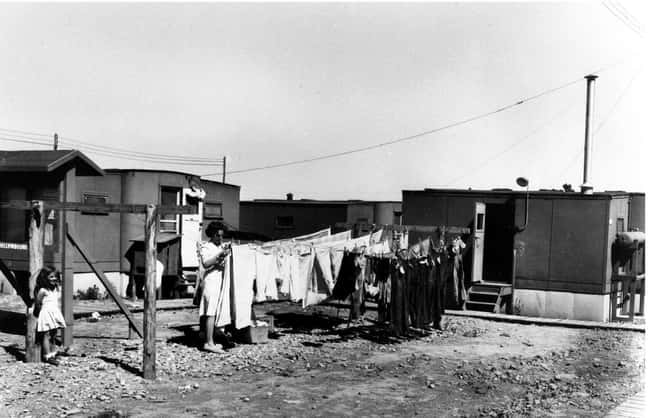
Even Children At Los Alamos Had Security Cards
At Los Alamos, children attended a school run largely by the wives of the scientists and workers. The secret city even had its own school bus to transport children to school.
The arrangement was chaos at first, says Robert Howes Jr., who was a child during the Manhattan Project:
The first time [the bus] drove down the street, it opened the door and kids got out like hamsters all over the place. Nobody was expecting them not to be civilized. Cars had to screech to stop and everything, and after that the parents got together and tried to make rules for such things.
Children also had to follow the facility’s strict rules, with those as young as 6 receiving security IDs to enter and exit Los Alamos.
“If parents didn’t want their children going off of the Hill, all they had to do is take their ID card away from them and they weren’t going anywhere,” recalls Dolores Heaton. “Because at that time to get in and out of Los Alamos you had to have your badge and your ID card. There were no ifs, ands, or buts about that.”
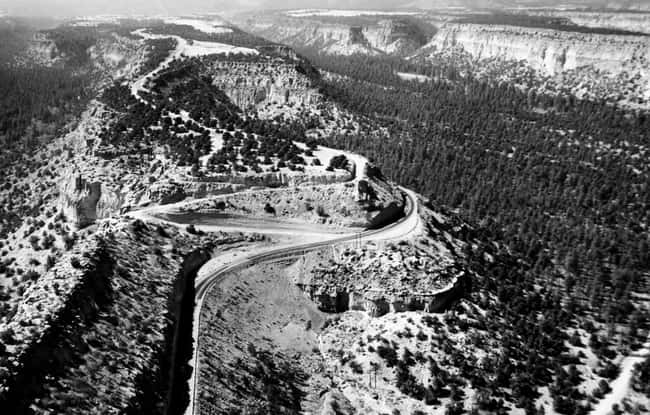
The Remote Facility Created Major Challenges For Residents
It wasn’t easy getting to Los Alamos. Built atop a plateau in New Mexico, it could only be accessed by dirt roads. During the rainy season, the roads turned into a muddy mess.
Residents were allowed to leave the facility one day a month. “You couldn’t buy a thread – a spool of thread – anything on the Hill,” says Rebecca Diven. “And if you made the mistake of saying, ‘I’m going to town,’ [meaning Santa Fe] you left with a long list of purchases for people.”
The facility did have a bus to Santa Fe, which Diven says operated on a “sort of” regular schedule that enabled residents to reach the stores around the time they opened. As Diven recalls, “I could get back in half a day and go hiking, whatever, and do the shopping we needed because there was nothing here in ’44. I loved it. I thought it was wonderful – mud, dust, wind, that’s all right.”
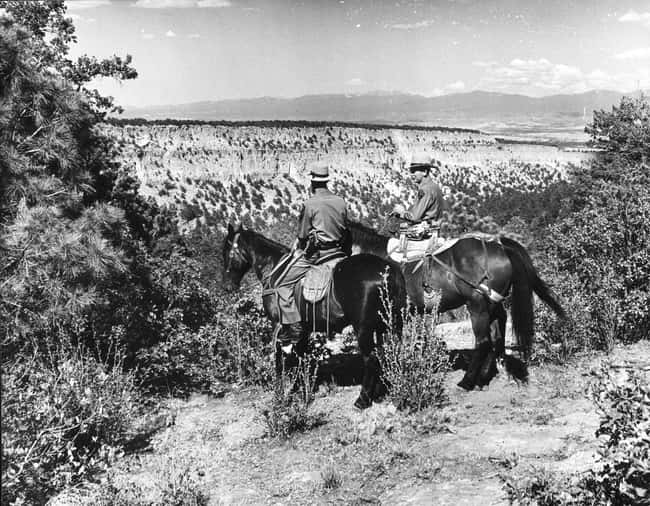
On Days Off, Physicists Took Horseback Rides
Scientists and workers from across the country came to Los Alamos to work on the Manhattan Project. Many were stunned by the beautiful scenery in New Mexico.
“More than once, somebody would bang on my door before breakfast and say, ‘Wake up! It’s snow. Let’s go skiing!'” remembers Rebecca Diven. “I’d jump up and we’d ski, and miss breakfast incidentally, and then I’d get to work in time. I thought that was heaven. Imagine being able to go right out of your dorm room into a place where you could ski or hike in the mountains.”
Dolores Heaton recalls the natural beauty: “It was one of the most beautiful settings I think that I’ve ever seen in my life. We were covered by mountains on all sides – north, south, east, west were nothing but huge, huge mountains. They were absolutely incredible.”
On their days off, scientists sometimes explored the setting on horseback.
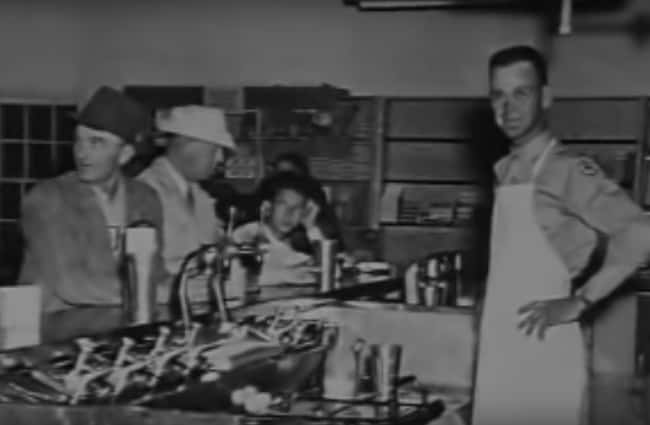
After The Trinity Test, Things Changed At Los Alamos
Life in Los Alamos blended the normal routines of work, school, and chores with a massive scientific undertaking to build a devastating device. As the Trinity test drew closer, that reality overwhelmed normal life.
John Mench remembers:
There were a lot of serious moments when the Trinity shot began to come into being. We worked very hard. Some of us worked sixteen hours a day, not because we were paid a lot of money, but because we knew that this could be the end of [WWII], and we put our heart and soul into getting that bomb prepared.
After the Trinity test succeeded, J. Robert Oppenheimer made a speech to Los Alamos residents: “You are heroes today, but in a very short time you will be criticized for what you have done here.”
Mench says, “He was very right.”
–
(For the source of this, and many other equally interesting articles, please visit: https://www.ranker.com/list/los-alamos-history/genevieve-carlton/)










I am now 94 and I visited Los Alamos with Dr. Oppenheimer’s Assistant, Dr. Worth Seagondollar Bill Dorrity